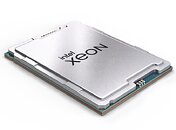- Joined
- Oct 9, 2007
- Messages
- 47,880 (7.38/day)
- Location
- Dublin, Ireland
| System Name | RBMK-1000 |
|---|---|
| Processor | AMD Ryzen 7 5700G |
| Motherboard | Gigabyte B550 AORUS Elite V2 |
| Cooling | DeepCool Gammax L240 V2 |
| Memory | 2x 16GB DDR4-3200 |
| Video Card(s) | Galax RTX 4070 Ti EX |
| Storage | Samsung 990 1TB |
| Display(s) | BenQ 1440p 60 Hz 27-inch |
| Case | Corsair Carbide 100R |
| Audio Device(s) | ASUS SupremeFX S1220A |
| Power Supply | Cooler Master MWE Gold 650W |
| Mouse | ASUS ROG Strix Impact |
| Keyboard | Gamdias Hermes E2 |
| Software | Windows 11 Pro |
The HEDT/workstation segment is heating up, with Intel preparing to launch a new line of low(er) core-count processor models with I/O features competitive to those of the AMD Ryzen Threadripper 7000 series for the AMD TRX50 platform. The new W-2500 series is designed for the same Intel W790 chipset Socket LGA4677 motherboards as the W-2400 series, but with increased CPU core-counts across the board. The top W-2500 series processor model comes with a 26-core/52-thread core-configuration, 2 MB of dedicated L2 cache per core, and 48.75 MB of shared L3 cache.
Where the Intel Xeon W-2500 series aces over the AMD Ryzen Threadripper 7000 (TRX50), is the platform I/O. While both processors offer a 4-channel DDR5 interface, the Intel chip offers a 64-lane PCI-Express Gen 5 root complex, in comparison to the 48-lane PCIe Gen 5 root complex from the processor. The TRX50 platform itself adds up to 88 PCIe lanes, but only 48 of these are Gen 5. The W-2500 series includes seven processor models, with the lowest model giving you 8-core/16-thread, and the highest one being 26-core/52-thread. Here the Threadripper 7000 TRX50 has a distinct advantage, as it offers core counts of up to 64-core/128-thread.

The series begins with the W3-2525 and W3-2535. The W3-2525 is an 8-core/16-thread model with a TDP of 175 W, clock speed of 3.50 GHz base, 4.50 GHz boost, 2 MB per core L2 cache, and 22.5 MB L3 cache. The W3-2535 goes a step up, with 10-core/20-thread, 185 W TDP, 4.60 GHz boost, and 26.25 MB L3 cache.
A notch above are the W5-2545, W5-2555X, and W5-2565X. The W5-2545 is 12-core/24-thread, with a 210 W TDP, 4.70 GHz maximum boost frequency, and 30 MB of shared L3 cache. The W5-2555X has the same 210 W TDP, but steps up to 14-core/28-thread, 4.80 GHz maximum boost frequency, and 33.75 MB L3 cache. The W5-2565X steps up the core counts to 18-core/36-thread, or what used to be the highest core counts for Intel HEDT processors under the Core X brand. It has the same 4.80 GHz maximum boost frequency as the W-2555X, but the additional cores mean that the TDP is stepped up to 240 W.
At the top of the product stack are the Xeon W7-2575X and W7-2595X. The W7-2575X comes with a core count of 22-core/44-thread, the same 240 W TDP as the W-2565X, the same 4.80 GHz boost frequency, but 45 MB of L3 cache. At the very top, is the W7-2595X, with 26-core/52-thread of muscle, 250 W TDP, 4.80 GHz maximum boost frequency, and 48.75 MB L3 cache.

View at TechPowerUp Main Site | Source
Where the Intel Xeon W-2500 series aces over the AMD Ryzen Threadripper 7000 (TRX50), is the platform I/O. While both processors offer a 4-channel DDR5 interface, the Intel chip offers a 64-lane PCI-Express Gen 5 root complex, in comparison to the 48-lane PCIe Gen 5 root complex from the processor. The TRX50 platform itself adds up to 88 PCIe lanes, but only 48 of these are Gen 5. The W-2500 series includes seven processor models, with the lowest model giving you 8-core/16-thread, and the highest one being 26-core/52-thread. Here the Threadripper 7000 TRX50 has a distinct advantage, as it offers core counts of up to 64-core/128-thread.

The series begins with the W3-2525 and W3-2535. The W3-2525 is an 8-core/16-thread model with a TDP of 175 W, clock speed of 3.50 GHz base, 4.50 GHz boost, 2 MB per core L2 cache, and 22.5 MB L3 cache. The W3-2535 goes a step up, with 10-core/20-thread, 185 W TDP, 4.60 GHz boost, and 26.25 MB L3 cache.
A notch above are the W5-2545, W5-2555X, and W5-2565X. The W5-2545 is 12-core/24-thread, with a 210 W TDP, 4.70 GHz maximum boost frequency, and 30 MB of shared L3 cache. The W5-2555X has the same 210 W TDP, but steps up to 14-core/28-thread, 4.80 GHz maximum boost frequency, and 33.75 MB L3 cache. The W5-2565X steps up the core counts to 18-core/36-thread, or what used to be the highest core counts for Intel HEDT processors under the Core X brand. It has the same 4.80 GHz maximum boost frequency as the W-2555X, but the additional cores mean that the TDP is stepped up to 240 W.
At the top of the product stack are the Xeon W7-2575X and W7-2595X. The W7-2575X comes with a core count of 22-core/44-thread, the same 240 W TDP as the W-2565X, the same 4.80 GHz boost frequency, but 45 MB of L3 cache. At the very top, is the W7-2595X, with 26-core/52-thread of muscle, 250 W TDP, 4.80 GHz maximum boost frequency, and 48.75 MB L3 cache.

View at TechPowerUp Main Site | Source




